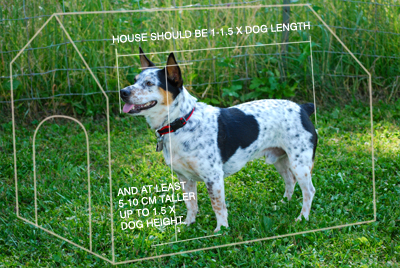
We have done a lot of research into sizing dog houses and there are a lot of ideas out there. In fact we have found 14 different sets of rules or mathematical formulae for dog house size, and none of them completely agree! So this is clearly not an exact science, and we suggest that you don't take any of them too literally. Instead we have tried to condense all their advice into some general rules that will help you decide which house to buy.
GENERAL RULES
The one thing that most people agree on is that your dog kennel should be big enough for your dog to stand up, turn around and lie down. Dogs are naturally drawn to burrows and caves, so they won't mind dipping their heads to get in and out.
The other general rule is that the house should be large enough to be comfortable, but that dogs prefer them to be snug. Especially if you live somewhere that gets cold in winter, keeping the house on the small side will let your dog feel secure and help them to retain body heat. If you live somewhere warm then something a bit more spacious might be more comfortable and will help with ventilation, although dogs still like to feel enclosed.
LENGTH
If you put together all the different theories, general advice is that the kennel should be between 1 - 1.5 times the length of your dog. Measure this from his nose to the end of his body, not including the tail.
HEIGHT
The kennel should be at least 5-10cm taller than your dog, and can go up to about 1.5 times your dog's height. This is the height from the ground to the top of his head while standing.
WIDTH
This is perhaps the least critical, which may be why there is the least agreement. Some people say the width of the house should be at least the length of your dog; others think 1-1.5 times the length of your dog; others say it should be narrower - about 2/3 the length of your dog. Probably a good rule of thumb is to keep to your dogs length plus or minus 30%. A little wider would be OK, but don't go any narrower.
DOOR
Your dog will be happy to crouch going in and out of his kennel, so the door just needs to be at least 70% of your dogs height at the shoulder. You are unlikely to find a dog house that fits your dog but where the door is too small.
AND FINALLY
All these rules need to be taken with a pinch of salt! At the end of the day all dogs are different shapes and sizes, and unless you are building a custom kennel you need to find the best fit you can. Your Basset Hound might be half the height of your Doberman but could be the same length, in which case you would probably need to get them the same kennel. And a small German Shepherd in the Blue Mountains might want a much smaller kennel than a large German Shepherd in Darwin. So use your common sense and adapt any advice you read to fit your dog.
Our House Sizes
The following is a guide only - different types of dog houses are slightly different shapes and sizes. The A-frame wooden houses are generally a little shorter and taller than the flat roof ones for example. So please check the exact dimensions for the house you are wanting to purchase.
SMALL
The difference between a small dog house and a medium dog house is very often only 10-20cm, and small dogs will generally be able to stay cosy and warm in a medium house, so we only stock small sizes in the plastic and soft crates where the extra portability is a big advantage. The small soft carriers are suited to dogs up to 45cm long and 40cm high; the small plastic houses for dogs up to 75cm long and 50cm high.
MEDIUM
Dog lengths up to 85cm
Dog heights vary - up to 55-65cm for flat roofed houses and 70cm for A frame houses.
LARGE
Dog lengths from 70-105cm (the plastic dog houses are slightly shorter - max length 90cm)
Dog heights from 45-70cm (again the plastic dog houses are slightly shorter - max height 60cm)
X LARGE
Dog lengths from 75-120cm (the A-frame houses are slightly shorter - max length 110cm)
Dog heights from 55-75cm (the A-frame houses are taller - up to 90cm max height)
Average Dog Sizes
Individual dogs vary a lot, so please do not use this calculator to determine how big your dog is. But if you want to get an idea of what you need, or how big your puppy might get, the following measurements are taken from breed averages.
It is important also that these measurements represent the dogs height at the shoulder, NOT the head height as is generally used for working out kennel sizes. As a very rough estimate for most breeds the head height will be around 25% taller than the shoulder height. Then, depending on the breed, the overall length will usually be a bit more than the head height. (Tall dogs like Boxers are more or less square; dogs like Cattle Dogs or Jack Russells will be about 10% longer than they are tall - this is probably the most common; hounds tend to be a little longer; and Dachshunds and Basset Hounds are about 30% longer than they are tall).
So if your dog's height at the shoulder is 40cm, its head height is probably 50cm and if it is an average shaped breed then its overall length is probably around 55cm.